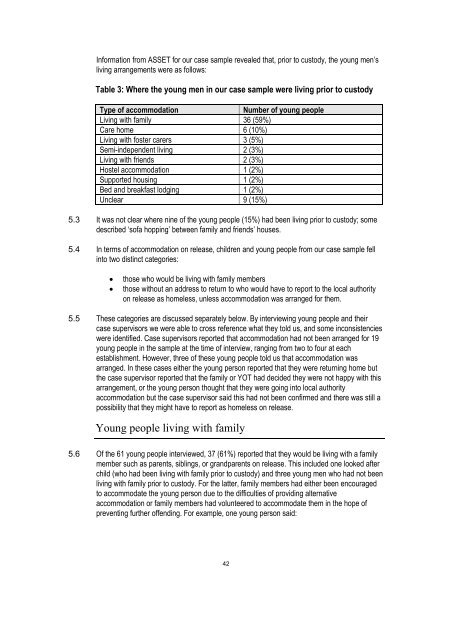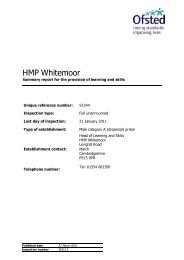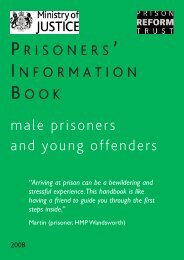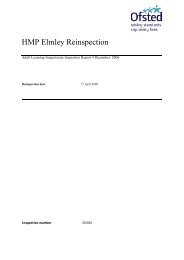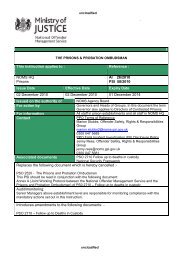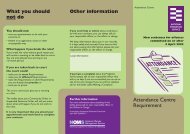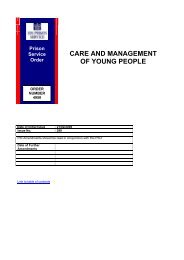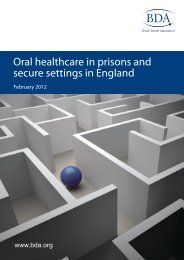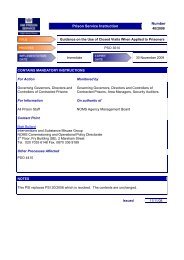Resettlement provision for children and young ... - Ministry of Justice
Resettlement provision for children and young ... - Ministry of Justice
Resettlement provision for children and young ... - Ministry of Justice
Create successful ePaper yourself
Turn your PDF publications into a flip-book with our unique Google optimized e-Paper software.
In<strong>for</strong>mation from ASSET <strong>for</strong> our case sample revealed that, prior to custody, the <strong>young</strong> men’s<br />
living arrangements were as follows:<br />
Table 3: Where the <strong>young</strong> men in our case sample were living prior to custody<br />
Type <strong>of</strong> accommodation<br />
Number <strong>of</strong> <strong>young</strong> people<br />
Living with family 36 (59%)<br />
Care home 6 (10%)<br />
Living with foster carers 3 (5%)<br />
Semi-independent living 2 (3%)<br />
Living with friends 2 (3%)<br />
Hostel accommodation 1 (2%)<br />
Supported housing 1 (2%)<br />
Bed <strong>and</strong> breakfast lodging 1 (2%)<br />
Unclear 9 (15%)<br />
5.3 It was not clear where nine <strong>of</strong> the <strong>young</strong> people (15%) had been living prior to custody; some<br />
described ‘s<strong>of</strong>a hopping’ between family <strong>and</strong> friends’ houses.<br />
5.4 In terms <strong>of</strong> accommodation on release, <strong>children</strong> <strong>and</strong> <strong>young</strong> people from our case sample fell<br />
into two distinct categories:<br />
<br />
<br />
those who would be living with family members<br />
those without an address to return to who would have to report to the local authority<br />
on release as homeless, unless accommodation was arranged <strong>for</strong> them.<br />
5.5 These categories are discussed separately below. By interviewing <strong>young</strong> people <strong>and</strong> their<br />
case supervisors we were able to cross reference what they told us, <strong>and</strong> some inconsistencies<br />
were identified. Case supervisors reported that accommodation had not been arranged <strong>for</strong> 19<br />
<strong>young</strong> people in the sample at the time <strong>of</strong> interview, ranging from two to four at each<br />
establishment. However, three <strong>of</strong> these <strong>young</strong> people told us that accommodation was<br />
arranged. In these cases either the <strong>young</strong> person reported that they were returning home but<br />
the case supervisor reported that the family or YOT had decided they were not happy with this<br />
arrangement, or the <strong>young</strong> person thought that they were going into local authority<br />
accommodation but the case supervisor said this had not been confirmed <strong>and</strong> there was still a<br />
possibility that they might have to report as homeless on release.<br />
Young people living with family<br />
5.6 Of the 61 <strong>young</strong> people interviewed, 37 (61%) reported that they would be living with a family<br />
member such as parents, siblings, or gr<strong>and</strong>parents on release. This included one looked after<br />
child (who had been living with family prior to custody) <strong>and</strong> three <strong>young</strong> men who had not been<br />
living with family prior to custody. For the latter, family members had either been encouraged<br />
to accommodate the <strong>young</strong> person due to the difficulties <strong>of</strong> providing alternative<br />
accommodation or family members had volunteered to accommodate them in the hope <strong>of</strong><br />
preventing further <strong>of</strong>fending. For example, one <strong>young</strong> person said:<br />
42


